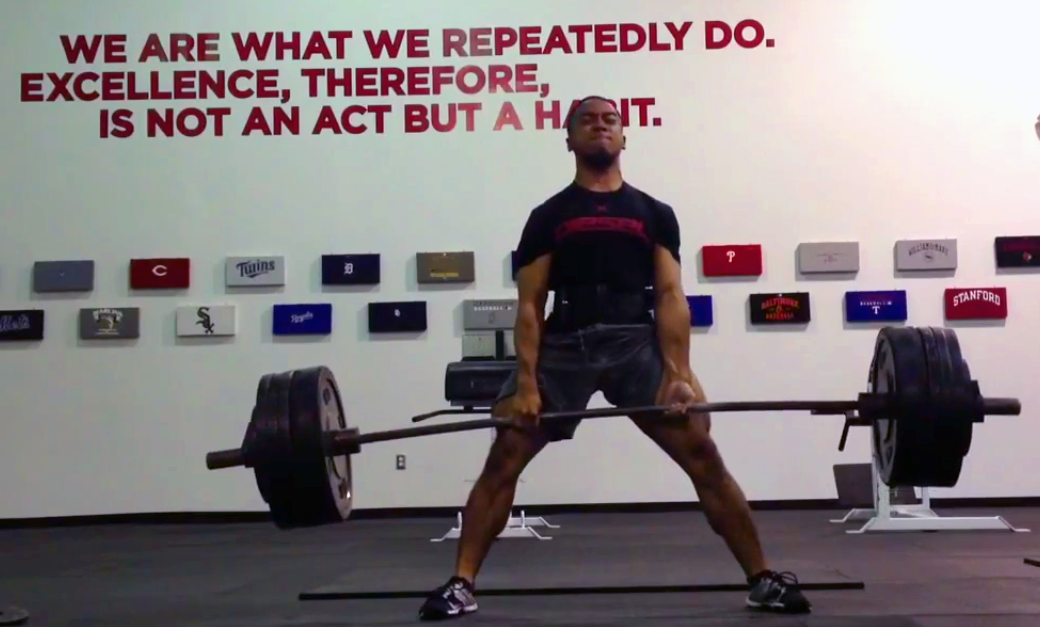There have been many combinations that have proven to be awesome in times past.
Peanut butter and jelly.
Rum and coke.
However, when it comes to exercise combinations, not many are as potent as deadlifts and kneeling glute mobilizations.
Before I digress down the combination, here are a few questions to keep in mind:
- When is too much mobility ever the issue?
- If you are too mobile, you need to display an appropriate amount of stability within that given range of motion.

To take a practical note from my assessments with my athletes, there has been a larger shift towards a lack of internal rotation displayed within the hips, and an increase in external rotation range of motion.
There are plenty of different ways hips can present, and to be fair on all sides, there have been plenty of people who have more hip internal vs external range of motion, or even a unilateral or shift in one versus the other hip’s values.
Now, it is imperative to first take another step back and realize that this is not only indicative of the femoral position within the hip joint, but also what is occurring positionally at the hip. The hip can present in either an anterior pelvic tilt, posterior pelvic tilt, or a shift in one or the other (one hip is anteriorly tilted, the other posteriorily tilted). This isn’t saying one or the other is bad, however it is just something to take note of from an objective point of view.
With this in mind, if there is a lack of hip internal rotation, it can be attributed to either osseous (bony) adaptations, or a soft tissue restriction, and secondarily a lack of lateral or anterior core stability.
Essentially, the hip can play into how the femur presents. So whenever I do assessments, this is something that I keep in mind to not focus in on a minute detail – because it is always part of a bigger picture.
Often on Day 1 of an athlete’s return to exercise (after a long and grueling season), they just want to get lifting again. However, if little Johnny can’t get his femur into specific positions, or even hold a stable position during a lift, it is unlikely that he will be successful. Johnny needs more mobility before he can improve further.
So, from our last exercise combination, we know that the femur must display a posterior glide into the acetabulum as hip flexion occurs. And there are tons of exercises that require hip flexion – step ups, squats, and everyone’s favorite – deadlifts.

So, other than motor control, a stretching of the posterior hip capsule might be necessary to stimulate receptors within the joint – a sort of way to “wake up” the sleepy butt muscles by providing a stretch reflex to the joints that are involved in the movement.
A1. Kneeling Glute Mobilization
A2. Sumo Deadlift
The exercise order matters in this specific case – that is, mobility allows for the hip joint to receive input to allow for more range of motion to occur, and then that mobility is not only capitalized on by performing an exercise that requires more mobility, but this new range is also “stabilized” by activating the muscles of the posterior chain – the ones that were just stretched into a further range of motion.
Further, two incorrect things often happen with the deadlift.
- Knees collapsing (so using the thought of the path of least resistance, if the hip isn’t going to move… the knees will move in its stead).
- Flexion of the lumbar spine (if there is not enough stability within the abdominal musculature or a bracing strategy is utilized, often L4-L5 of the lumbar spine will flex due to its susceptibility to flexion range of motion).
These items matter because if there is not enough flexibility of the posterior hip muscles, and your glutes are essentially stiff, then you won’t be able to hip hinge appropriately.
You’ll break down either at the lumbar spine or the knees.
For efficiency’s sake, the order matters because if you perform your given number of sets and reps of your mobilization, and you are aiming to hit some big numbers, there is less reason to capitalize on the newly found mobility AFTER you’ve already deadlifted (if the sequence was switched around).
You might as well not be doing the drill, or do one less set to reduce redundancy, and save on time. (This gives you more time for making PB&J sandwiches, ya?)
Some modifications on the choice of deadlift involve using a trap bar deadlift, conventional deadlift, RDL, or in actuality any type of hip hinging exercise.
You should see a pattern here – whenever you sit back, or whenever you perform hip flexion, you need a specific type of mobility in the hips. If you lack that mobility, where else will you achieve that range of motion?
As always,
Keep it funky.

